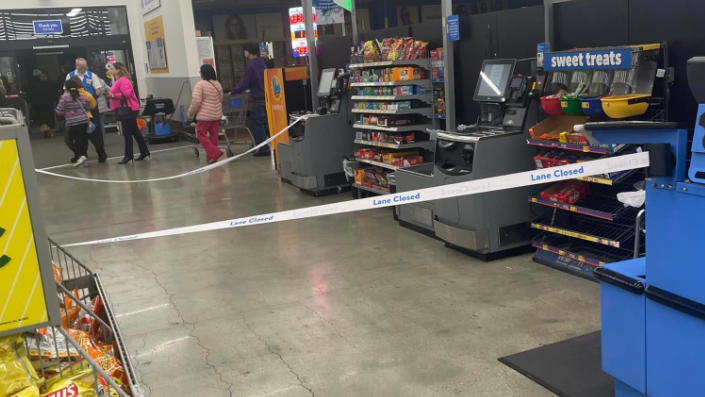LOS ANGELES – For a while, they looked to be the future of shopping.
Grocery stores, home improvement stores and retail chains were all making room for those blinking green lanes of sweeping, modern shopping convenience (or so they said) – the self-checkouts where you become cashier and bagger.
If you’ve ever visited Target on a Sunday evening and have seen the snaking lane of self-checkout customers weaving into the store, you know.
But you may be seeing fewer of them in major retailers nowadays, and you can blame California’s retail crime wave.

On social media, one user recently posted this picture of the Walmart in West Hills – with the self-checkout lanes roped off. The post said all Wal-Marts have removed self-checkouts due to theft.
We reached out to Wal-Mart to find out if the self-checkout lanes were indeed a thing of the past. Are they removing all of them in California? Which stores have had them removed (or simply closed, temporarily or otherwise)?
A Wal-Mart spokesperson told us they needed to research the issue.
They later replied, saying, “We’re always looking at ways to innovate and improve our stores. We have nothing to announce related to self-checkout removals at this time.”
When pressed for specifics, the retailer offered none.
“I’ll refer you to the previous statement. That’s the only comment we have.”
It’s the not-so-secret secret: retail chains are doing away with these lanes, and many do not want to talk about it.
In December, SFGATE.com reported that Target quietly removed self-checkouts in San Francisco, calling it “a trend in ‘defensive retailing’ that may soon spread across the city.”
Other reports say Target, when it does allow self-checkout, is only doing so for customers with ten items or less. No more big carts full of items.
KTLA reached out to Target as well. No response.
Other chains, including Costco, have been dealing with the issue, saying that “shrink,” or the measure by which chains track retail theft, has increased in part due to the rollout of self-checkout.
KTLA reached out to Costco as well. No response.
Two years ago, when KTLA 5 News consumer expert David Lazarus reported on Kohl’s, H&M, Bed Bath & Beyond, and Zara all testing self-checkouts, he noted “It’s obvious why the [self-checkout] technology is attractive to businesses. One of their top expenses is labor. So, any form of automation that reduces human interaction with customers is money in the company’s pocket.”
Now, California crime trends may be proving too costly.
LAPD data from 2023 shows retail theft up 16% in the city of Los Angeles. Many of those crimes involve “flash mob-style” attacks on retailers.
Reported shoplifting incidents rose in the Bay Area, and shoplifting is trending up in Los Angeles and other urban areas.
It’s definitely a big-city issue. The Public Policy Institute of California found shoplifting levels did not increase in California’s smaller counties and actually fell in some areas.
For those who are sticking with self-checkout, The Associated Press says Kroger is one of the companies now using artificial intelligence which can tell when a shopper fails to scan an item. If the customer fails to resolve the issue, they get the dreaded red light at the self-checkout and a call for customer service help.
Love them or hate them. That may be where self-checkout evolves next.
Lazarus ended his 2022 column by saying, “The thing is, many consumers don’t like self-checkout”.
It’s true. Many don’t like it.
And now based on crime trends, many stores may be rethinking it.











